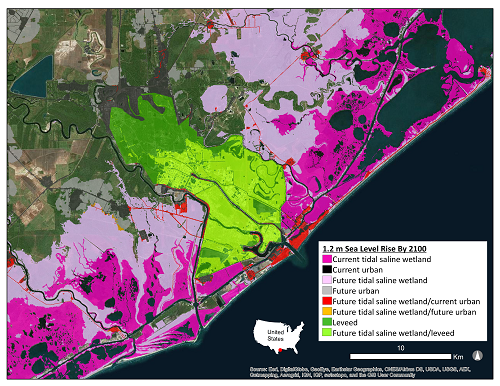In the 21st century, accelerated sea-level rise and coastal development are expected to greatly alter coastal landscapes across the globe. The future of mangrove forests, salt marshes, and salt flats (i.e., tidal saline wetlands, collectively) is uncertain, and coastal environmental managers are increasingly challenged to develop conservation strategies that will increase the resilience of these valuable ecosystems. One strategy for preparing for the effects of sea-level rise is to ensure that there is space available for tidal saline wetlands to adapt to sea-level rise. USGS scientists used alternative future sea-level rise and urbanization scenarios to show where tidal saline wetlands may adapt via landward migration, where barriers may prevent landward migration, and how existing protected lands might accommodate expected landward migration. The analyses spanned five U.S. Gulf Coast States—Texas, Lousiana, Mississippi, Alabama, and Florida—and evaluated three sea-level rise scenarios and a business-as-usual future urbanization scenario.
At the region level, the analyses show that there is a massive amount of land along the U.S. Gulf of Mexico coast that is available for the landward migration of tidal saline wetlands. These areas consist of upslope and upriver ecosystems that are vulnerable to ecological regime shifts induced by sea-level rise. The county-level analyses show that much of the migration is expected to be concentrated along certain coastlines (e.g., Collier, Monroe, and Miami-Dade Counties in Florida; Assumption, Cameron, Lafourche, Terrebonne, St. Mary, and Vermilion Parishes in Louisiana). Topographic constraints are expected to limit the extent of landward migration along some coastal reaches. Migration barriers due to current and future urban development are expected to be highest in Florida, especially along the coastline that extends from Tampa to Fort Meyers. Although Louisiana is expected to experience the most landward migration of any State, much of the migration is expected to occur on unprotected lands (i.e., lands not owned by Federal, State, local, or private institutions with the capacity for continued conservation). In contrast, much of the anticipated landward migration in southern Florida is expected to occur on protected lands. Collectively, these analyses provide information that can be used to identify migration corridors and develop future-focused adaptation strategies that will improve the potential that the ecosystem goods and services provided by tidal saline wetlands will continue to be available for future generations.
http://pubs.usgs.gov/ds/0969/ds969.html

Tidal saline wetland migration and barriers expected for a 1.2-m sea-level rise by 2100 near Freeport, Texas. This study focused solely on assessing the area available for landward migration of tidal saline wetlands (depicted in light purple) and did not make any predictions regarding the ability of existing tidal saline wetland (depicted in magenta) to keep pace with sea-level rise via vertical accretion.

